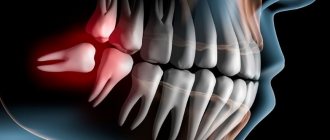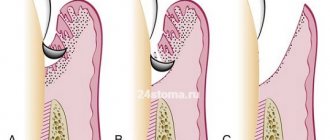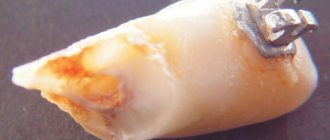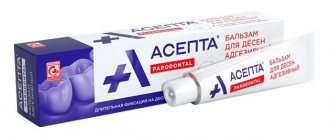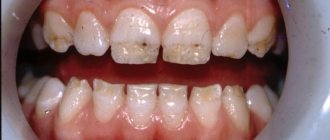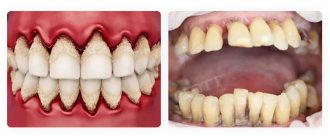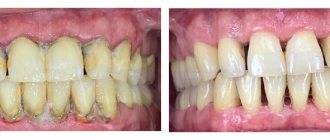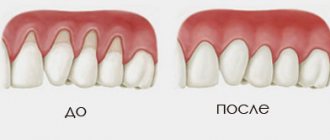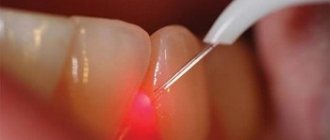Osteosynthesis is a surgical treatment for a jaw fracture , which involves the use of special, most often metal, plates to fix the fragments. The operation is performed in cases where connecting bone elements with a splint is difficult or impossible, or it is difficult to fix them in the correct position. In modern practice, several methods of jaw osteosynthesis using plates are used. The choice of a specific technique depends on the severity of the injury and its nature.
Features of the splinting procedure
In dentistry, there are many types of diseases that can potentially increase tooth mobility. This causes severe discomfort and negatively affects the condition of the jaw apparatus. It becomes difficult for a person to chew and he has to adhere to a special diet.
To solve this problem, you need to use a splinting technique. At its core, this is a procedure for strengthening teeth, which allows you to connect several units in a row and protect them from falling out.
The application of a splint is necessary so that there is not such a strong load on the gums, and other treatment methods can be freely applied. At the same time, it will be much more comfortable for the patient to chew different types of food.
Unloading tissue with splinting helps reduce the intensity of the inflammatory process. This is especially useful for periodontitis, when it is necessary to keep the gums in a calm state while doctors carry out general sanitation and restore damaged teeth.
In this material we will tell you in more detail how teeth splinting is done, what products are used in the process, and also touch on many other important issues regarding the procedure.
Let's sum it up
Dental splinting is a procedure that has helped many people save teeth that they would have lost with a 100% chance. There is no more effective treatment method yet. In addition, the cost of many techniques remains affordable for the vast majority of patients. Of course, we are not talking about clasp dentures.
For many patients, the discreetness of the splint is of great importance. Modern technologies in dental practice make it possible to perform the procedure in such a way that the teeth look as natural as possible. Manufacturers of materials specially select them to match the tone of dental tissues, just like fillings.
For what reasons does the dentition become mobile?
Doctors identify many reasons why patients need to be splinted. And these include such types of diseases as:
Periodontitis. The main reason for its appearance is poor oral hygiene, as well as the characteristics of the microflora. A strong build-up of tartar can often stimulate the inflammatory process and loosen teeth. In this case, there is a gradual destruction of the fixing ligament, which connects the tooth to other tissues.
- Periodontal disease. It can be quite easily determined by external examination. The gums become whitish, although any negative sensations and pain are practically not observed. Gradually, the volume of the gums decreases, and bare roots become very noticeable. Due to insufficient supporting tissues, the tooth begins to loosen over time. Periodontal disease is often observed in patients with a weakened body due to systemic diseases or long-term treatment.
- Injury. Problems can begin if a jaw fracture has been recorded.
Other categories of patients are also at risk. If you smoke a lot, neglect advice on regular oral hygiene, or suffer from metabolic disorders, you can develop severe tooth mobility. It also manifests itself due to age or poor nutrition.
What can you eat during treatment?
During bone healing, certain nutritional difficulties arise. The patient cannot chew as before, so food must be liquid and at the same time fully cover the need for vitamins and minerals.
Doctors recommend eating the following foods:
- baby formulas and cereals;
- pureed vegetables and fruits;
- broths, puree soups;
- milk, kefir, fermented baked milk, yoghurts;
- porridge with milk;
- grated meat diluted in milk or broth.
After the splint is removed, you should start eating solid food gradually. This will not only allow you to gradually develop the chewing function, but will also prepare the stomach for normal nutrition and prevent disturbances in its functioning.
Indications and contraindications for splinting
The decision about whether splinting can be performed in a particular case is made by the doctor. It is important that the technique has no contraindications and is effective.
There are several main common indications:
- Severe changes in the position of teeth or loosening due to periodontitis.
- Trauma – fractures of the upper or lower jaw.
- Reducing the volume of gum tissue.
- The gum pockets reach a size of 5 mm.
- Exposed roots.
There are also a number of contraindications for the procedure. Splinting cannot be performed when the patient has caries on the supporting teeth or severely inflamed gums. Also, restrictions are imposed if a person has too sensitive enamel or has a reaction to various materials of the system’s components.
It is also worth preparing for the fact that after splinting you will need to follow the rules of oral hygiene. Here the situation is similar to wearing braces - you will need to carefully monitor how well you brush your teeth.
First aid
In case of a fracture, the following steps should be taken before being examined by a doctor:
- fix the jaw with a bandage, as shown in the photo (similar to splinting the lower jaw);
- if there is bleeding, stop it, compress the artery;
- Apply a cold compress to the fracture site;
- free the mouth from blood, adjust the tongue so that the victim can breathe;
- relieve pain with analgin-based drugs;
- A person with such a fracture can only be transported lying on his side to avoid tongue retraction.
After all these measures, you should immediately consult a doctor. Having a damaged jaw is very dangerous and can cause serious complications. The best and safest option is to call an ambulance. Usually people with such injuries are admitted to the maxillofacial department.
What materials are used when splinting a tooth?
The cost and other parameters of tire installation will greatly depend on what materials the system was made from. Let's look at the most common ones:
- Fiberglass thread. Fiberglass splinting of teeth is completed in just one and a half to two hours. You can expect at least three years of active use.
- Aramid fiber. Also in demand when performing splinting. It is valued for its careful attitude towards the enamel - after removal there is no damage left on it.
- Polyethylene. It is valuable because it is well tolerated by the mucous membrane and causes virtually no discomfort when worn even by sensitive people.
- Metal. Classic material for making retainers. Perfectly holds teeth in the desired position.
- Silk. This fiber can also be used; it is gentle on both mucous membranes and enamel, but is characterized by low strength.
- Ceramics. Typically used when permanent prosthetics are planned. Problems may arise due to the fact that the method is quite labor-intensive and expensive.
It is also possible to use metal-ceramics in the process. It is durable and quite affordable.
Recovery period
The period of restoration of jaw functionality depends on the following factors:
- severity, type of fracture;
- duration of treatment;
- absence or presence of complications;
- patient's age;
- the presence of concomitant internal diseases.
Returning the joint to full function is not always possible. Here the responsibility and diligence of the patient himself comes to the fore. To restore healthy jaw function, you must strictly follow all prescribed recommendations. Long-term, scrupulous rehabilitation is the key to normal functioning of the jaw joints.
Rehabilitation measures:
- Exercise therapy for developing joints. All exercises are performed with full amplitude, even with pain;
- regular courses of therapeutic massage;
- physiotherapeutic procedures - paraffin applications, mud therapy, ultrasound, electrophoresis with calcium, UV irradiation in winter;
- gentle food.
Benefits of the procedure
This procedure really helps to significantly reduce mobility and reduce stress on the gums. Periodontitis slows down, and restoration of normal chewing ability has a positive effect on the digestive process.
The procedure also has a positive effect on the patient’s personal comfort. The space between his teeth becomes smaller - this removes the psychological pressures that prevent many people from smiling normally.
Modern systems are designed so that you can talk in them calmly. Food restrictions are minimal.
Disadvantages of the method
The main disadvantage is that when installing the tire, you will need to carry out special mechanical processing of the enamel.
It is also worth considering that the product cannot be used by all patients. Much depends on the patient himself. He needs to be attentive to oral hygiene and brush his teeth on time. Otherwise, the risk of caries occurring and developing is very high. Hygiene itself will also become more difficult.
When installing a tire, you need to remember the adaptation process. During the first few days, there may be severe tooth sensitivity to sour, hot and cold foods.
Types of teeth splinting
There are many parameters to classify such a procedure. One of the main ones is location. The tire can be installed in two options:
- Frontal. Usually placed in the gap next to the incisors and canines.
- Lateral. Placed on a group of chewing teeth.
It is also possible to install a special clasp design - it is more expensive, but allows you to use both jaws.
Another difference parameter is the division into permanent and temporary splinting. Typically, a temporary option is indicated when the disease is just beginning to develop and the gums have not become too thin. This type of splinting is also allowed when there are injuries and deformations of the dentition.
An option with permanent splinting is also possible, when long-term stabilization is ensured. When choosing between a clasp prosthesis and permanent splinting, many patients prefer the first option because it is more aesthetically pleasing.
As the name implies, temporary and permanent structures differ in terms of wearing time:
- Temporary. Typically used between a few days and several months. This option allows you to correctly distribute the load and prevents serious damage to the mucous membrane. The design itself is quite simple, so it can be easily put on and taken off. Depending on the patient's current condition, the number of units to be splinted is selected. Common materials used in manufacturing are plastic and metal.
- Permanent. Suitable if you need to fix a tooth for many years. The advantage is that a truly reliable fixation is created, and the time spent adapting to such a design is greatly reduced.
You need to understand that the process of oral hygiene when using permanent prosthetics will become more difficult. You also need to pay attention that all tasks within the framework of dental treatment must be completed before the splint is installed - then it will be much more difficult.
Rehabilitation
Complete regeneration of bone tissue is a long process that involves changing the patient’s usual lifestyle. Removal of the fixing structure occurs no earlier than a month after installation. After splinting, the patient is prescribed a course of strengthening therapy and physiotherapeutic procedures.
To restore chewing function and strengthen muscle tissue, the patient performs facial gymnastics. It is possible to speed up the regeneration process by taking vitamin complexes containing vitamins B, C, D. If there is pronounced pain and swelling, the patient attends a magnetic therapy procedure.
Teeth splinting methods
At the first appointment, the dentist assesses the current condition of the oral cavity and takes an x-ray. The task before him is to understand how much the bone tissue has thinned. You also need to determine the degree of tooth mobility, see what condition the bite is in, and whether there are any irregularities or other problems.
The condition of the gums is also of great importance, because it allows you to understand what methods can be used for splinting, what are the risks of irritation or other problems arising.
Installation of a splint is allowed only if there are no contraindications for this and no inflammation is observed. Sanitation of the oral cavity and treatment of caries may also be required. This becomes especially important when the installation of permanent permanent structures is planned.
Splinting using fiberglass
Fiberglass splinting is one of the most common methods. It is usually used when you need to connect several teeth and save as much as possible. The duration of use of one tire does not exceed two years - after this period it will be necessary to install a new one.
The entire installation process does not take more than two hours. First you need to clean the enamel, then create a small groove on it. After this, the fiberglass tape is fixed to the composite materials. After the structure is polished, the doctor is convinced that nothing is bothering the patient, the work is considered completed.
This technique is needed in order to splint teeth in case of periodontal disease. The choice of this method is supported by a high level of strength, good compatibility with dental tissues and affordability.
Screw method
The main material for this splinting is armid thread. This method can be used when a person is injured.
Splinting teeth for jaw fractures and increased mobility allows you to get noticeable results.
The installation process is similar to what has already been described above. First, the enamel is cleaned, then a groove is created. A cord of armid thread is stretched in the recess.
Clasp remedy
This technique refers to methods of permanent prosthetics and is suitable if you need to stabilize the dentition with severe loosening.
The use of modern means makes it possible to prepare abutments and crowns so that large gaps between teeth can be prevented.
Securing crowns
The product is suitable for you if you need to fix four teeth in a row at once. In this case, you will need to install crowns that connect. The installation is the same as in the cases described above. The main difference is the laboratory installation of crowns, as well as their fitting before placing them on permanent cement.
Splinting for periodontitis
This splinting option will be used if there is severe destruction of bone tissue. In this case, you need to apply a splint as quickly as possible in order to qualitatively reduce mobility and prevent further progression of tissue atrophy.
Splinting for injuries
Splinting teeth for fractures is a common practice. In this case, the doctor is tasked with preventing the manifestation of asymmetry. Temporary restorations are often prescribed to restore the correct position of the teeth throughout the recovery period.
Splinting after braces
Sometimes splinting must be used after the patient removes braces. In this case, the tire acts as a retainer. It allows you to prevent tooth displacement, which could lead to spoiling the result of many months of treatment.
Diagnostic methods
- initial examination and palpation;
- X-ray;
- CT scan;
- orthopantomography;
- masticationography;
- gnathodynamometry;
- myography;
- thermal imaging;
- rheography;
- MRI.
X-ray
X-ray diagnostics is a mandatory procedure that reliably shows the presence of a fracture, its complexity, pathology, whether there are fragments and problems with the roots of the teeth. X-rays do not require any additional preparation. However, pregnant women, patients with bleeding and people in serious condition should avoid it.
httpv://www.youtube.com/watch?v=embed/dgvFXBTYVJ0
Usually several photographs are taken in frontal, lateral and axial projection:
- In direct projection, the image usually shows the general condition of the jaw. It is done lying on the stomach on the front side.
- Lateral x-rays are used as a complement to the first. It shows large defects and the condition of the teeth. The patient is placed on the desired side and the cassette is applied to the cheek.
- The axial projection shows bilateral fractures of the mandible, as well as defects due to trauma to the articular and condylar process of the mandible. The patient is placed on his stomach and his chin is pulled out.
Inspection and palpation
During examination, facial asymmetry also signals an injury. Bleeding in the eyes may indicate a fracture of the base of the skull. The same is indicated by the discharge of cerebrospinal fluid (CSF) from the nose.
It is often confused with ordinary bleeding, but it is more dangerous and can lead to inflammation of the brain and significant weakening of the body. How badly a person will be affected depends on their anatomy.
Only after the examination is completed, the doctor begins palpation. The sensitivity of the skin of the nose and lips must be checked to find out whether the infraorbital nerve is damaged. When there is a suspicion of a fracture of the lower jaw (condylar process), its base and the posterior edge of the branch are palpated.
These are its narrowest parts. If it is impossible to palpate at least one head, we can talk about injury to the condylar and articular process. To determine the location of the injury to the upper jaw, the doctor presses on the wisdom teeth or last molars.
Make an appointment to install a splint on your teeth
If you have an indication for teeth splinting, make an appointment with our clinic. Clients come to us from different cities - Khimki, Kurkino, Novogorsk and many others.
We guarantee a professional approach from dentists with extensive experience, fast treatment and the use of high-quality materials.
To make an appointment for your first consultation and examination with a dentist, simply leave a request on the website or call us. We will answer your questions and tell you which treatment option is right for your situation. We also provide many other services in the field of medical or aesthetic dentistry.

